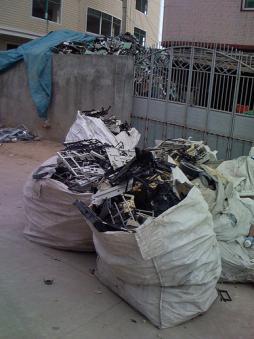The United Nations Environment Programme has released a new study on managing e-waste for developing countries. The report focuses one three major points: the market potential of e-waste recycling, encouraging the adoption of the UNEP’s guidelines to foster innovation in e-waste recycling technologies, and identifying places in which e-waste recycling is thriving. The study acknowledges that data of e-waste is insufficient, but the United Nations University estimates “that current e-waste arising across the twenty-seven members of the European Usnion amount to around 8.3 – 9.1 million per year; global arising are estimated to be around 40 million tons per year.”
The report used data from 11 representative developing countries to estimate current and future e-waste generation - which includes old and dilapidated desk and laptop computers, printers, mobile phones, pagers, digital photo and music devices, refrigerators, toys and televisions.
In South Africa and China for example, the report predicts that by 2020 e-waste from old computers will have jumped by 200 to 400 percent from 2007 levels, and by 500% in India
By that same year in China, e-waste from discarded mobile phones will be about 7 times higher than 2007 levels and, in India, 18 times higher.
With so much e-waste, which includes hazardous materials are well as recyclable metals, glass and plastics, the study focuses on best practices in disposing of and reusing electronics. The study makes the excellent point that e-waste management is not only about containing and managing hazardous materials, but also about keeping valuable resources in the market: “More collection of electrical and electronic appliances allows for more efficient recycling, keeps valuable e-waste components (e.g. metals) in the economy and safely disposes of its harmful components in order to prevent risks to human health and the environment. Therefore, increased take-back and innovative recycling technologies at the different steps of the recycling chain can generate genuinely sustainable products and services and can create new markets.” E-waste recycling can be used to create sustainable businesses in developing countries as there is a need to manage hazardous materials while salvaging valuable materials. The study notes that better management of e-waste can result in side benefits for developing countries, including job creation, improved local knowledge of technology and environmental benefits. The study divides eleven countries into groups of “promising” (Kenya, Uganda, Senegal, Peru), “having significant potential for the introduction of pre- and end-processing technologies” (India, China), and “having significant potential to adapt pre- and to some extent end-processing technologies" (South Africa, Morocco, Colombia, Mexico, Brazil). The report’s identification of market potential is one of it’s strongest points, showing distinct waste management opportunities which are applicable to each country (for example, the potential of each country to manually dismantle e-waste or to de-gas chlorofluorocarbons). The report is dense, but the break-down of e-waste management potential could be invaluable. As e-waste continues to pile up at greater rates each year, looking for new markets and innovative management technologies while highlighting centers of excellence is a good start to encouraging better e-waste management solutions.
Image courtesy of Flickr user Bert van Djik
| How to Manage e- (and m-) Waste: The UNEP Investigates data sheet 4822 Views | |
|---|---|
| Countries: | Brazil China Colombia India Kenya Mexico Morocco Peru Senegal South Africa Uganda |


Post new comment